Advancements in Mixed-Matrix Membranes for Various Separation Applications: State of the Art and Future Prospects
Abstract
:1. Introduction
1.1. Fundamentals of Mixed-Matrix Membranes (MMM)
1.2. Types of Fillers
1.3. Types of Polymers
2. Recent Advances in MMM Fabrication Techniques
2.1. Phase Inversion (PI) Physical Blending Technique
2.1.1. Phase Inversion Method for Fabricating Flat Sheet NCMs
2.1.2. Fabrication of Hollow Fiber Membranes (HFMs) Using Nanoparticle Incorporated Dope Solutions
2.2. Electrospinning
2.3. Layer-by-Layer (LbL) Self-Assembly
3. Performance Enhancement Strategies
3.1. Matrix-Level Modification of Membranes
3.2. Surface Modification of Membranes
4. Characterization Techniques for MMMs
4.1. Morphological Characterization
4.1.1. Scanning Electron Microscopy (SEM)
4.1.2. Atomic Force Microscopy (AFM)
4.1.3. Transmission Electron Microscopy (TEM)
4.2. Structural Characterization
4.2.1. X-Ray Diffraction (XRD)
4.2.2. Fourier-Transform Infrared Spectroscopy (FTIR)
4.3. Performance Characterization
4.3.1. Pure Water Flux (PWF)
4.3.2. Fouling Studies
4.3.3. Permeation Studies
5. Applications of MMMs in Separation Processes
5.1. Water and Wastewater Treatment
5.1.1. Water Purification
5.1.2. Antifouling and Antibacterial Activity
5.1.3. Dye Removal
5.1.4. Heavy Metal Removal
5.2. Gas Separation
5.3. Membrane Distillation (MD) and Forward Osmosis (FO)
5.4. Pervaporation (PV)
6. Challenges and Future Directions
7. Conclusions
Author Contributions
Funding
Data Availability Statement
Acknowledgments
Conflicts of Interest
References
- Fane, A.G.; Wang, R.; Jia, Y. Membrane Technology: Past, Present and Future. In Membrane and Desalination Technologies; Humana Press: Totowa, NJ, USA, 2011; pp. 1–45. [Google Scholar] [CrossRef]
- Membrane Separation Technology Market Size Report. 2030. Available online: https://www.grandviewresearch.com/industry-analysis/membrane-separation-technology-market (accessed on 2 January 2023).
- Nanomaterials Market Size, Growth, Trends | Report 2022–2030. Available online: https://www.precedenceresearch.com/nanomaterials-market (accessed on 2 January 2023).
- Baig, N.; Kammakakam, I.; Falath, W.; Kammakakam, I. Nanomaterials: A Review of Synthesis Methods, Properties, Recent Progress, and Challenges. Mater. Adv. 2021, 2, 1821–1871. [Google Scholar] [CrossRef]
- Jhaveri, J.H.; Murthy, Z.V.P. Nanocomposite Membranes. Desalination Water Treat. 2016, 57, 26803–26819. [Google Scholar] [CrossRef]
- Kamali, M.; Suhas, D.P.; Costa, M.E.; Capela, I.; Aminabhavi, T.M. Sustainability Considerations in Membrane-Based Technologies for Industrial Effluents Treatment. Chem. Eng. J. 2019, 368, 474–494. [Google Scholar] [CrossRef]
- Wen, Y.; Yuan, J.; Ma, X.; Wang, S.; Liu, Y. Polymeric Nanocomposite Membranes for Water Treatment: A Review. Environ. Chem. Lett. 2019, 17, 1539–1551. [Google Scholar] [CrossRef]
- Li, H.; Yu, P.; Li, H.; Luo, Y. The Chlorination and Chlorine Resistance Modification of Composite Polyamide Membrane. J. Appl. Polym. Sci. 2015, 132, 41584. [Google Scholar] [CrossRef]
- Taha, Y.R.; Zrelli, A.; Hajji, N.; Alsalhy, Q.; Shehab, M.A.; Németh, Z.; Hernadi, K. Optimum Content of Incorporated Nanomaterials: Characterizations and Performance of Mixed Matrix Membranes a Review. Desalination Water Treat. 2024, 317, 100088. [Google Scholar] [CrossRef]
- Ezugbe, E.O.; Rathilal, S. Membrane Technologies in Wastewater Treatment: A Review. Membranes 2020, 10, 89. [Google Scholar] [CrossRef]
- Malhotra, B.D.; Ali, M.A. Nanomaterials in Biosensors: Fundamentals and Applications. In Nanomaterials for Biosensors; Elsevier: Amsterdam, The Netherlands, 2018; pp. 1–74. [Google Scholar] [CrossRef]
- Rabajczyk, A.; Zielecka, M.; Cygańczuk, K.; Pastuszka, Ł.; Jurecki, L. Nanometals-Containing Polymeric Membranes for Purification Processes. Materials 2021, 14, 513. [Google Scholar] [CrossRef]
- Bissadi, G.; Kruczek, B. Thermal Properties of Silica/Poly(2,6-Dimethyl-1,4-Phenylene Oxide) Films Prepared by Emulsion Polymerization. J. Therm. Anal. Calorim. 2014, 117, 73–83. [Google Scholar] [CrossRef]
- Wang, X.; Wang, L.; Su, Q.; Zheng, J. Use of Unmodified SiO2 as Nanofiller to Improve Mechanical Properties of Polymer-Based Nanocomposites. Compos. Sci. Technol. 2013, 89, 52–60. [Google Scholar] [CrossRef]
- Baratta, M.; Nezhdanov, A.V.; Mashin, A.I.; Nicoletta, F.P.; De Filpo, G. Carbon Nanotubes Buckypapers: A New Frontier in Wastewater Treatment Technology. Sci. Total Environ. 2024, 924, 171578. [Google Scholar] [CrossRef] [PubMed]
- Alaei Shahmirzadi, M.A.; Kargari, A. Nanocomposite Membranes. In Emerging Technologies for Sustainable Desalination Handbook; Butterworth-Heinemann: Oxford, UK, 2018; pp. 285–330. [Google Scholar] [CrossRef]
- Guo, X.; Qiao, Z.; Liu, D.; Zhong, C. Mixed-Matrix Membranes for CO2 Separation: Role of the Third Component. J. Mater. Chem. A 2019, 7, 24738–24759. [Google Scholar] [CrossRef]
- Monsalve-Bravo, G.M.; Bhatia, S.K. Modeling Permeation through Mixed-Matrix Membranes: A Review. Process 2018, 6, 172. [Google Scholar] [CrossRef]
- Salahshoori, I.; Seyfaee, A.; Babapoor, A. Recent Advances in Synthesis and Applications of Mixed Matrix Membranes. Synth. Sinter. 2021, 1, 1–27. [Google Scholar] [CrossRef]
- Farnam, M.; bin Mukhtar, H.; bin Mohd Shariff, A. A Review on Glassy and Rubbery Polymeric Membranes for Natural Gas Purification. ChemBioEng. Rev. 2021, 8, 90–109. [Google Scholar] [CrossRef]
- Mulder, M. MEMBRANE PREPARATION | Phase Inversion Membranes. In Encyclopedia of Separation Science; Elsevier: Amsterdam, The Netherlands, 2000; pp. 3331–3346. [Google Scholar]
- Ismail, A.F.; Khulbe, K.C.; Matsuura, T. Introduction—Do RO Membranes Have Pores? In Reverse Osmosis; Elsevier: Amsterdam, The Netherlands, 2019; pp. 1–24. [Google Scholar] [CrossRef]
- Tan, X.; Robijns, S.; Thür, R.; Ke, Q.; De Witte, N.; Lamaire, A.; Li, Y.; Aslam, I.; Van Havere, D.; Donckels, T.; et al. Truly Combining the Advantages of Polymeric and Zeolite Membranes for Gas Separations. Science 2022, 378, 1189–1194. [Google Scholar] [CrossRef] [PubMed]
- Ang, M.B.M.Y.; Devanadera, K.P.O.; Duena, A.N.R.; Luo, Z.Y.; Chiao, Y.H.; Millare, J.C.; Aquino, R.R.; Huang, S.H.; Lee, K.R. Modifying Cellulose Acetate Mixed-Matrix Membranes for Improved Oil–Water Separation: Comparison between Sodium and Organo-Montmorillonite as Particle Additives. Membranes 2021, 11, 80. [Google Scholar] [CrossRef] [PubMed]
- Geleta, T.A.; Maggay, I.V.; Chang, Y.; Venault, A. Recent Advances on the Fabrication of Antifouling Phase-Inversion Membranes by Physical Blending Modification Method. Membranes 2023, 13, 58. [Google Scholar] [CrossRef] [PubMed]
- Marbelia, L.; Ilyas, A.; Dierick, M.; Qian, J.; Achille, C.; Ameloot, R.; Vankelecom, I.F.J. Preparation of Patterned Flat-Sheet Membranes Using a Modified Phase Inversion Process and Advanced Casting Knife Construction Techniques. J. Memb. Sci. 2020, 597, 117621. [Google Scholar] [CrossRef]
- Bazzarelli, F.; Giorno, L. Encyclopedia of Membranes; Springer Science and Business Media LLC: Dordrecht, The Netherlands, 2020; pp. 1–3. [Google Scholar] [CrossRef]
- Moghadam, M.T.; Lesage, G.; Mohammadi, T.; Mericq, J.P.; Mendret, J.; Heran, M.; Faur, C.; Brosillon, S.; Hemmati, M.; Naeimpoor, F. Improved Antifouling Properties of TiO2/PVDF Nanocomposite Membranes in UV-Coupled Ultrafiltration. J. Appl. Polym. Sci. 2015, 132, 13–15. [Google Scholar] [CrossRef]
- Efome, J.E.; Baghbanzadeh, M.; Rana, D.; Matsuura, T.; Lan, C.Q. Effects of Superhydrophobic SiO2 Nanoparticles on the Performance of PVDF Flat Sheet Membranes for Vacuum Membrane Distillation. Desalination 2015, 373, 47–57. [Google Scholar] [CrossRef]
- Maheswari, P.; Prasannadevi, D.; Mohan, D. Preparation and Performance of Silver Nanoparticle Incorporated Polyetherethersulfone Nanofiltration Membranes. High Perform. Polym. 2013, 25, 174–187. [Google Scholar] [CrossRef]
- Thakur, B.K.; De, S. A Novel Method for Spinning Hollow Fiber Membrane and Its Application for Treatment of Turbid Water. Sep. Purif. Technol. 2012, 93, 67–74. [Google Scholar] [CrossRef]
- Moch, I. Hollow-Fiber Membranes. In Kirk-Othmer Encyclopedia of Chemical Technology; John Wiley & Sons, Inc.: New York, NY, USA, 2000. [Google Scholar]
- Hebbar, R.S.; Isloor, A.M.; Ananda, K.; Abdullah, M.S.; Ismail, A.F. Fabrication of a Novel Hollow Fiber Membrane Decorated with Functionalized Fe2O3 Nanoparticles: Towards Sustainable Water Treatment and Biofouling Control. New J. Chem. 2017, 41, 4197–4211. [Google Scholar] [CrossRef]
- Saberi, S.; Shamsabadi, A.A.; Shahrooz, M.; Sadeghi, M.; Soroush, M. Improving the Transport and Antifouling Properties of Poly(Vinyl Chloride) Hollow-Fiber Ultrafiltration Membranes by Incorporating Silica Nanoparticles. ACS Omega 2018, 3, 17439–17446. [Google Scholar] [CrossRef]
- Turken, T.; Sengur-Tasdemir, R.; Koseoglu-Imer, D.Y.; Koyuncu, I. Determination of Filtration Performances of Nanocomposite Hollow Fiber Membranes with Silver Nanoparticles. Environ. Eng. Sci. 2015, 32, 656–665. [Google Scholar] [CrossRef]
- Gezmis-Yavuz, E.; Cansoy, C.E.; Koseoglu-Imer, D.Y. Fabrication of Mixed Matrix Nanofibers with Electrospraying and Electrospinning Techniques and Their Application to Gas Toluene Removal. J. Environ. Chem. Eng. 2023, 11, 110067. [Google Scholar] [CrossRef]
- Siddique, T.; Dutta, N.K.; Choudhury, N.R. Mixed-Matrix Membrane Fabrication for Water Treatment. Membranes 2021, 11, 557. [Google Scholar] [CrossRef]
- Elmarghany, M.R.; El-Shazly, A.H.; Rajabzadeh, S.; Salem, M.S.; Shouman, M.A.; Sabry, M.N.; Matsuyama, H.; Nady, N. Triple-Layer Nanocomposite Membrane Prepared by Electrospinning Based on Modified PES with Carbon Nanotubes for Membrane Distillation Applications. Membranes 2020, 10, 15. [Google Scholar] [CrossRef]
- Balu, R.; Mata, J.; Dutta, N.K.; Choudhury, R.; Electrospun, N.; Pucci, A.; Araya-Hermosilla, R.; Araya-Hermosilla, E.; Siddique, T.; Balu, R.; et al. Electrospun Composite Nanofiltration Membranes for Arsenic Removal. Polymers 2022, 14, 1980. [Google Scholar] [CrossRef]
- Richardson, J.J.; Cui, J.; Björnmalm, M.; Braunger, J.A.; Ejima, H.; Caruso, F. Innovation in Layer-by-Layer Assembly. Chem. Rev. 2016, 116, 14828–14867. [Google Scholar] [CrossRef] [PubMed]
- Guo, D.; Xiao, Y.; Li, T.; Zhou, Q.; Shen, L.; Li, R.; Xu, Y.; Lin, H. Fabrication of High-Performance Composite Nanofiltration Membranes for Dye Wastewater Treatment: Mussel-Inspired Layer-by-Layer Self-Assembly. J. Colloid Interface Sci. 2020, 560, 273–283. [Google Scholar] [CrossRef] [PubMed]
- Ahmad, N.A.; Goh, P.S.; Wong, K.C.; Mamah, S.C.; Ismail, A.F.; Zulhairun, A.K. Accelerated Spraying-Assisted Layer by Layer Assembly of Polyethyleneimine/Titania Nanosheet on Thin Film Composite Membrane for Reverse Osmosis Desalination. Desalination 2022, 529, 115645. [Google Scholar] [CrossRef]
- McShane, M.J.; Lvov, Y.M. Electrostatic Self-Assembly: Layer-by-Layer. In Dekker Encyclopedia of Nanoscience and Nanotechnology, 3rd ed.; CRC Press: New York, NY, USA, 2014; pp. 1342–1358. [Google Scholar] [CrossRef]
- Harsini, I.; Sadiq, M.M.; Soroushian, P.; Balachandra, A.M. Polymer Nanocomposites Processed via Self-Assembly through Introduction of Nanoparticles, Nanosheets, and Nanofibers. J. Mater. Sci. 2017, 52, 1969–1980. [Google Scholar] [CrossRef]
- Dhar, J.; Patil, S. Self-Assembly and Catalytic Activity of Metal Nanoparticles Immobilized in Polymer Membrane Prepared via Layer-by-Layer Approach. ACS Appl. Mater. Interfaces 2012, 4, 1803–1812. [Google Scholar] [CrossRef] [PubMed]
- Liu, G.; Jiang, Z.; Li, C.; Hou, L.; Chen, C.; Yang, H.; Pan, F.; Wu, H.; Zhang, P.; Cao, X. Layer-by-Layer Self-Assembled Nanocomposite Membranes via Bio-Inspired Mineralization for Pervaporation Dehydration. J. Memb. Sci. 2019, 570, 44–52. [Google Scholar] [CrossRef]
- Wang, S.; Wei, X.; Li, Z.; Liu, Y.; Wang, H.; Zou, L.; Lu, D.; Hassan Akhtar, F.; Wang, X.; Wu, C.; et al. Recent Advances in Developing Mixed Matrix Membranes Based on Covalent Organic Frameworks. Sep. Purif. Technol. 2022, 301, 122004. [Google Scholar] [CrossRef]
- Li, R.; Chen, J.P.; Freger, V. A New Fabrication Approach for Mixed Matrix Membrane Fabricated with Interstitially Sealed MOF Nanoparticles. J. Memb. Sci. 2023, 671, 121357. [Google Scholar] [CrossRef]
- Zhao, M.; Guo, J.; Xin, Q.; Zhang, Y.; Li, X.; Ding, X.; Zhang, L.; Zhao, L.; Ye, H.; Li, H.; et al. Novel Aminated F-Ce Nanosheet Mixed Matrix Membranes with Controllable Channels for CO2 Capture. Sep. Purif. Technol. 2023, 324, 124512. [Google Scholar] [CrossRef]
- Cheng, Y.; Joarder, B.; Datta, S.J.; Alsadun, N.; Poloneeva, D.; Fan, D.; Khairova, R.; Bavykina, A.; Jia, J.; Shekhah, O.; et al. Mixed Matrix Membranes with Surface Functionalized Metal–Organic Framework Sieves for Efficient Propylene/Propane Separation. Adv. Mater. 2023, 35, 2300296. [Google Scholar] [CrossRef]
- Guo, H.; Dai, R.; Xie, M.; Peng, L.E.; Yao, Z.; Yang, Z.; Nghiem, L.D.; Snyder, S.A.; Wang, Z.; Tang, C.Y. Tweak in Puzzle: Tailoring Membrane Chemistry and Structure toward Targeted Removal of Organic Micropollutants for Water Reuse. Environ. Sci. Technol. Lett. 2022, 9, 247–257. [Google Scholar] [CrossRef]
- Shoshaa, R.; Ashfaq, M.Y.; Al-Ghouti, M.A. Recent Developments in Ultrafiltration Membrane Technology for the Removal of Potentially Toxic Elements, and Enhanced Antifouling Performance: A Review. Environ. Technol. Innov. 2023, 31, 103162. [Google Scholar] [CrossRef]
- Bowden, N.B. Nanomaterials-Based Membranes Increase Flux and Selectivity to Enable Chemical Separations. ACS Appl. Nano Mater. 2020, 3, 9538–9541. [Google Scholar] [CrossRef]
- Zainuddin, M.I.F.; Ahmad, A.L. Mixed Matrix Membrane Development Progress and Prospect of Using 2D Nanosheet Filler for CO2 Separation and Capture. J. CO2 Util. 2022, 62, 102094. [Google Scholar] [CrossRef]
- Mei, X.; Yang, S.; Lu, P.; Zhang, Y.; Zhang, J. Improving the Selectivity of ZIF-8/Polysulfone-Mixed Matrix Membranes by Polydopamine Modification for H2/CO2 Separation. Front. Chem. 2020, 8, 551750. [Google Scholar] [CrossRef] [PubMed]
- Basile, A.; Gugliuzza, A.; Iulianelli, A.; Morrone, P. Membrane Technology for Carbon Dioxide (CO2) Capture in Power Plants. In Advanced Membrane Science and Technology for Sustainable Energy and Environmental Applications; Elsevier: Amsterdam, The Netherlands, 2011; pp. 113–159. [Google Scholar] [CrossRef]
- Nikita, K.; Ray, D.; Aswal, V.K.; Murthy, C.N. Surface Modification of Functionalized Multiwalled Carbon Nanotubes Containing Mixed Matrix Membrane Using Click Chemistry. J. Memb. Sci. 2020, 596, 117710. [Google Scholar] [CrossRef]
- Zhang, C.; Ma, M.Q.; Chen, T.T.; Zhang, H.; Hu, D.F.; Wu, B.H.; Ji, J.; Xu, Z.K. Dopamine-Triggered One-Step Polymerization and Codeposition of Acrylate Monomers for Functional Coatings. ACS Appl. Mater. Interfaces 2017, 9, 34356–34366. [Google Scholar] [CrossRef] [PubMed]
- Wang, J.; Tian, J.; Gao, S.; Shi, W.; Cui, F. Dopamine Triggered One Step Polymerization and Codeposition of Reactive Surfactant on PES Membrane Surface for Antifouling Modification. Sep. Purif. Technol. 2020, 249, 117148. [Google Scholar] [CrossRef]
- Wang, C.; Ren, G.; Wei, K.; Liu, D.; Wu, T.; Jiang, J.; Qian, J.; Pan, Y. Improved Dispersion Performance and Interfacial Compatibility of Covalent-Grafted MOFs in Mixed-Matrix Membranes for Gas Separation. Green Chem. Eng. 2021, 2, 86–95. [Google Scholar] [CrossRef]
- Olonisakin, K.; Fan, M.; Xin-Xiang, Z.; Ran, L.; Lin, W.S.; Zhang, W.; Wenbin, Y. Key Improvements in Interfacial Adhesion and Dispersion of Fibers/Fillers in Polymer Matrix Composites; Focus on PLA Matrix Composites. Compos. Interfaces 2022, 29, 1071–1120. [Google Scholar] [CrossRef]
- Aroon, M.A.; Ismail, A.F.; Matsuura, T.; Montazer-Rahmati, M.M. Performance Studies of Mixed Matrix Membranes for Gas Separation: A Review. Sep. Purif. Technol. 2010, 75, 229–242. [Google Scholar] [CrossRef]
- Vu, M.T.; Monsalve-Bravo, G.M.; Lin, R.; Li, M.; Bhatia, S.K.; Smart, S. Mitigating the Agglomeration of Nanofiller in a Mixed Matrix Membrane by Incorporating an Interface Agent. Membranes 2021, 11, 328. [Google Scholar] [CrossRef]
- Alqaheem, Y.; Alomair, A.A. Microscopy and Spectroscopy Techniques for Characterization of Polymeric Membranes. Membranes 2020, 10, 33. [Google Scholar] [CrossRef]
- Huang, J.; Tang, H.; Huang, X.; Feng, Z.; Su, P.; Li, W. Hansen Solubility Parameters-Guided Mixed Matrix Membranes with Linker-Exchanged Metal-Organic Framework Fillers Showing Enhanced Gas Separation Performance. J. Memb. Sci. 2023, 668, 121238. [Google Scholar] [CrossRef]
- Hui Ting, L.L.; Teow, Y.H.; Mahmoudi, E.; Ooi, B.S. Development and Optimization of Low Surface Free Energy of RGO-PVDF Mixed Matrix Membrane for Membrane Distillation. Sep. Purif. Technol. 2023, 305, 122428. [Google Scholar] [CrossRef]
- Olejnik, A.; Nowak, I. Atomic Force Microscopy Analysis of Synthetic Membranes Applied in Release Studies. Appl. Surf. Sci. 2015, 355, 686–697. [Google Scholar] [CrossRef]
- Wang, L.; Song, X.; Wang, T.; Wang, S.; Wang, Z.; Gao, C. Fabrication and Characterization of Polyethersulfone/Carbon Nanotubes (PES/CNTs) Based Mixed Matrix Membranes (MMMs) for Nanofiltration Application. Appl. Surf. Sci. 2015, 330, 118–125. [Google Scholar] [CrossRef]
- Mukherjee, R.; Bhunia, P.; De, S. Impact of Graphene Oxide on Removal of Heavy Metals Using Mixed Matrix Membrane. Chem. Eng. J. 2016, 292, 284–297. [Google Scholar] [CrossRef]
- Zhao, C.; Xu, X.; Chen, J.; Yang, F. Effect of Graphene Oxide Concentration on the Morphologies and Antifouling Properties of PVDF Ultrafiltration Membranes. J. Environ. Chem. Eng. 2013, 1, 349–354. [Google Scholar] [CrossRef]
- Jhaveri, J.H.; Patel, C.M.; Murthy, Z.V.P. Preparation, Characterization and Application of GO-TiO2/PVC Mixed Matrix Membranes for Improvement in Performance. J. Ind. Eng. Chem. 2017, 52, 138–146. [Google Scholar] [CrossRef]
- Rezaee, R.; Nasseri, S.; Mahvi, A.H.; Nabizadeh, R.; Mousavi, S.A.; Rashidi, A.; Jafari, A.; Nazmara, S. Fabrication and Characterization of a Polysulfone-Graphene Oxide Nanocomposite Membrane for Arsenate Rejection from Water. J. Environ. Health Sci. Eng. 2015, 13, 1–11. [Google Scholar] [CrossRef]
- Tang, C.Y.; Yang, Z. Transmission Electron Microscopy (TEM); Elsevier B.V.: Amsterdam, The Netherlands, 2017; ISBN 9780444637918. [Google Scholar]
- Kuzminova, A.; Dmitrenko, M.; Zolotarev, A.; Markelov, D.; Komolkin, A.; Dubovenko, R.; Selyutin, A.; Wu, J.; Su, R.; Penkova, A. Novel Mixed Matrix Membranes Based on Poly(Vinylidene Fluoride): Development, Characterization, Modeling. Polymers 2023, 15, 1222. [Google Scholar] [CrossRef]
- Sonawane, A.V.; Murthy, Z.V.P. Synthesis and Characterization of ZIF-8-Based PVDF Mixed Matrix Membranes and Application to Treat Pulp and Paper Industry Wastewater Using a Membrane Bioreactor. Environ. Sci. Water Res. Technol. 2022, 8, 881–896. [Google Scholar] [CrossRef]
- Ahmad, M.W.; Dey, B.; Al Saidi, A.K.A.; Choudhury, A. Functionalized-Graphene Reinforced Polyethersulfone Nanocomposites with Improved Physical and Mechanical Properties. Polym. Compos. 2020, 41, 4104–4116. [Google Scholar] [CrossRef]
- Gu, S.; Li, L.; Liu, F.; Li, J. Biochar/Kevlar Nanofiber Mixed Matrix Nanofiltration Membranes with Enhanced Dye/Salt Separation Performance. Membranes 2021, 11, 443. [Google Scholar] [CrossRef]
- Poon, Y.K.; Enche Ab Rahim, S.K.; Ng, Q.H.; Hoo, P.Y.; Abdullah, N.Y.; Nasib, A.; Abdullah, N.S. Synthesis and Characterisation of Self-Cleaning TiO2/PES Mixed Matrix Membranes in the Removal of Humic Acid. Membranes 2023, 13, 373. [Google Scholar] [CrossRef]
- Nqombolo, A.; Mpupa, A.; Moutloali, R.M.; Nomngongo, P.N. Wastewater Treatment Using Membrane Technology. In Wastewater and Water Quality; IntechOpen: London, UK, 2018. [Google Scholar] [CrossRef]
- Diallo, M.S. Water Treatment by Dendrimer-Enhanced Filtration: Principles and Applications. In Nanotechnology Applications for Clean Water; Elsevier: Amsterdam, The Netherlands, 2009; pp. 143–155. [Google Scholar] [CrossRef]
- Emadzadeh, D.; Lau, W.J.; Ismail, A.F. Synthesis of Thin Film Nanocomposite Forward Osmosis Membrane with Enhancement in Water Flux without Sacrificing Salt Rejection. Desalination 2013, 330, 90–99. [Google Scholar] [CrossRef]
- Hani, U. Comprehensive Review of Polymeric Nanocomposite Membranes Application for Water Treatment. Alex. Eng. J. 2023, 72, 307–321. [Google Scholar] [CrossRef]
- Dong, H.; Zhao, L.; Zhang, L.; Chen, H.; Gao, C.; Winston Ho, W.S. High-Flux Reverse Osmosis Membranes Incorporated with NaY Zeolite Nanoparticles for Brackish Water Desalination. J. Memb. Sci. 2015, 476, 373–383. [Google Scholar] [CrossRef]
- Gahlot, S.; Sharma, P.P.; Gupta, H.; Kulshrestha, V.; Jha, P.K. Preparation of Graphene Oxide Nano-Composite Ion-Exchange Membranes for Desalination Application. RSC Adv. 2014, 4, 24662–24670. [Google Scholar] [CrossRef]
- Zhang, M.; Field, R.W.; Zhang, K. Biogenic Silver Nanocomposite Polyethersulfone UF Membranes with Antifouling Properties. J. Memb. Sci. 2014, 471, 274–284. [Google Scholar] [CrossRef]
- Akar, N.; Asar, B.; Dizge, N.; Koyuncu, I. Investigation of Characterization and Biofouling Properties of PES Membrane Containing Selenium and Copper Nanoparticles. J. Memb. Sci. 2013, 437, 216–226. [Google Scholar] [CrossRef]
- García, A.; Rodríguez, B.; Oztürk, D.; Rosales, M.; Diaz, D.I.; Mautner, A. Incorporation of CuO Nanoparticles into Thin-Film Composite Reverse Osmosis Membranes (TFC-RO) for Antibiofouling Properties. Polym. Bull. 2018, 75, 2053–2069. [Google Scholar] [CrossRef]
- Dong, L.X.; Yang, H.W.; Liu, S.T.; Wang, X.M.; Xie, Y.F. Fabrication and Anti-Biofouling Properties of Alumina and Zeolite Nanoparticle Embedded Ultrafiltration Membranes. Desalination 2015, 365, 70–78. [Google Scholar] [CrossRef]
- Lakhotia, S.R.; Mukhopadhyay, M.; Kumari, P. Iron Oxide (FeO) Nanoparticles Embedded Thin-Film Nanocomposite Nanofiltration (NF) Membrane for Water Treatment. Sep. Purif. Technol. 2019, 211, 98–107. [Google Scholar] [CrossRef]
- Karimi, A.; Khataee, A.; Vatanpour, V.; Safarpour, M. High-Flux PVDF Mixed Matrix Membranes Embedded with Size-Controlled ZIF-8 Nanoparticles. Sep. Purif. Technol. 2019, 229, 115838. [Google Scholar] [CrossRef]
- Hosseini, S.S.; Fakharian Torbati, S.; Alaei Shahmirzadi, M.A.; Tavangar, T. Fabrication, Characterization, and Performance Evaluation of Polyethersulfone/TiO2 Nanocomposite Ultrafiltration Membranes for Produced Water Treatment. Polym. Adv. Technol. 2018, 29, 2619–2631. [Google Scholar] [CrossRef]
- Rezakazemi, M.; Dashti, A.; Riasat Harami, H.; Hajilari, N.; Inamuddin. Fouling-Resistant Membranes for Water Reuse. Environ. Chem. Lett. 2018, 16, 715–763. [Google Scholar] [CrossRef]
- Bassyouni, M.; Abdel-Aziz, M.H.; Zoromba, M.S.; Abdel-Hamid, S.M.S.; Drioli, E. A Review of Polymeric Nanocomposite Membranes for Water Purification. J. Ind. Eng. Chem. 2019, 73, 19–46. [Google Scholar] [CrossRef]
- Al-Jadir, T.; Alardhi, S.M.; Alheety, M.A.; Najim, A.A.; Salih, I.K.; Al-Furaiji, M.; Alsalhy, Q.F. Fabrication and Characterization of Polyphenylsulfone/Titanium Oxide Nanocomposite Membranes for Oily Wastewater Treatment. J. Ecol. Eng. 2022, 23, 1–13. [Google Scholar] [CrossRef]
- Al-Ani, F.H.; Alsalhy, Q.F.; Raheem, R.S.; Rashid, K.T.; Figoli, A. Experimental Investigation of the Effect of Implanting TiO2-NPs on PVC for Long-Term UF Membrane Performance to Treat Refinery Wastewater. Membranes 2020, 10, 77. [Google Scholar] [CrossRef]
- Teow, Y.H.; Ahmad, A.L.; Lim, J.K.; Ooi, B.S. Studies on the Surface Properties of Mixed-Matrix Membrane and Its Antifouling Properties for Humic Acid Removal. J. Appl. Polym. Sci. 2013, 128, 3184–3192. [Google Scholar] [CrossRef]
- Bae, T.H.; Tak, T.M. Preparation of TiO2 Self-Assembled Polymeric Nanocomposite Membranes and Examination of Their Fouling Mitigation Effects in a Membrane Bioreactor System. J. Memb. Sci. 2005, 266, 1–5. [Google Scholar] [CrossRef]
- Vetrivel, S.; Rana, D.; Sri Abirami Saraswathi, M.S.; Divya, K.; Kaleekkal, N.J.; Nagendran, A. Cellulose Acetate Nanocomposite Ultrafiltration Membranes Tailored with Hydrous Manganese Dioxide Nanoparticles for Water Treatment Applications. Polym. Adv. Technol. 2019, 30, 1943–1950. [Google Scholar] [CrossRef]
- Behboudi, A.; Jafarzadeh, Y.; Yegani, R. Incorporation of Silica Grafted Silver Nanoparticles into Polyvinyl Chloride/Polycarbonate Hollow Fiber Membranes for Pharmaceutical Wastewater Treatment. Chem. Eng. Res. Des. 2018, 135, 153–165. [Google Scholar] [CrossRef]
- Zodrow, K.; Brunet, L.; Mahendra, S.; Li, D.; Zhang, A.; Li, Q.; Alvarez, P.J.J. Polysulfone Ultrafiltration Membranes Impregnated with Silver Nanoparticles Show Improved Biofouling Resistance and Virus Removal. Water Res. 2009, 43, 715–723. [Google Scholar] [CrossRef] [PubMed]
- Bitounis, D.; Ali-Boucetta, H.; Hee Hong, B.; Min, D.-H.; Kostarelos, K.; Bitounis, D.; Ali-Boucetta, H.; Kostarelos, K.; Hee Hong, B.; Min, D. Prospects and Challenges of Graphene in Biomedical Applications. Adv. Mater. 2013, 25, 2258–2268. [Google Scholar] [CrossRef]
- Kausar, A. Applications of Polymer/Graphene Nanocomposite Membranes: A Review. Mater. Res. Innov. 2019, 23, 276–287. [Google Scholar] [CrossRef]
- Zango, Z.U.; Khoo, K.S.; Ali, A.F.; Abidin, A.Z.; Zango, M.U.; Lim, J.W.; Wadi, I.A.; Eisa, M.H.; Alhathlool, R.; Abu Alrub, S.; et al. Development of Inorganic and Mixed Matrix Membranes for Application in Toxic Dyes-Contaminated Industrial Effluents with in-Situ Treatments. Environ. Res. 2024, 256, 119235. [Google Scholar] [CrossRef]
- Ayele, A.; Getachew, D.; Kamaraj, M.; Suresh, A. Phycoremediation of Synthetic Dyes: An Effective and Eco-Friendly Algal Technology for the Dye Abatement. J. Chem. 2021, 2021, 9923643. [Google Scholar] [CrossRef]
- Zheng, Y.; Yao, G.; Cheng, Q.; Yu, S.; Liu, M.; Gao, C. Positively Charged Thin-Film Composite Hollow Fiber Nanofiltration Membrane for the Removal of Cationic Dyes through Submerged Filtration. Desalination 2013, 328, 42–50. [Google Scholar] [CrossRef]
- Kadhim, R.J.; Al-Ani, F.H.; Al-Shaeli, M.; Alsalhy, Q.F.; Figoli, A. Removal of Dyes Using Graphene Oxide (GO) Mixed Matrix Membranes. Membranes 2020, 10, 366. [Google Scholar] [CrossRef] [PubMed]
- Bilal, A.; Yasin, M.; Akhtar, F.H.; Gilani, M.A.; Alhmohamadi, H.; Younas, M.; Mushtaq, A.; Aslam, M.; Hassan, M.; Nawaz, R.; et al. Enhancing Water Purification by Integrating Titanium Dioxide Nanotubes into Polyethersulfone Membranes for Improved Hydrophilicity and Anti-Fouling Performance. Membranes 2024, 14, 116. [Google Scholar] [CrossRef] [PubMed]
- El-sayed, M.M.H.; Elsayed, R.E.; Attia, A.; Farghal, H.H.; Azzam, R.A.; Madkour, T.M. Novel Nanoporous Membranes of Bio-Based Cellulose Acetate, Poly (Lactic Acid) and Biodegradable Polyurethane in-Situ Impregnated with Catalytic Cobalt Nanoparticles for the Removal of Methylene Blue and Congo Red Dyes from Wastewater. Carbohydr. Polym. Technol. Appl. 2021, 2, 100123. [Google Scholar] [CrossRef]
- Khumalo, N.P.; Vilakati, G.D.; Mhlanga, S.D.; Kuvarega, A.T.; Mamba, B.B.; Li, J.; Dlamini, D.S. Dual-Functional Ultra Fi Ltration Nano-Enabled PSf/PVA Membrane for the Removal of Congo Red Dye. J. Water Process Eng. 2019, 31, 100878. [Google Scholar] [CrossRef]
- Khumalo, N.P.; Nthunya, L.N.; De Canck, E.; Derese, S.; Verliefde, A.R.; Kuvarega, A.T.; Mamba, B.B.; Mhlanga, S.D.; Dlamini, D.S. Congo Red Dye Removal by Direct Membrane Distillation Using PVDF/PTFE Membrane. Sep. Purif. Technol. 2019, 211, 578–586. [Google Scholar] [CrossRef]
- Tan, Y.; Kang, Y.; Wang, W.; Lv, X.; Wang, B.; Zhang, Q.; Cui, C.; Cui, S.; Jiao, S.; Pang, G.; et al. Chitosan Modified Inorganic Nanowires Membranes for Ultra-Fast and Efficient Removal of Congo Red. Appl. Surf. Sci. 2021, 569, 150970. [Google Scholar] [CrossRef]
- Yadav, A.; Sharma, P.; Panda, A.B.; Shahi, V.K. Photocatalytic TiO2 Incorporated PVDF-Co-HFP UV-Cleaning Mixed Matrix Membranes for Effective Removal of Dyes from Synthetic Wastewater System via Membrane Distillation. J. Environ. Chem. Eng. 2021, 9, 105904. [Google Scholar] [CrossRef]
- Alaoui, O.T.; Nguyen, Q.T.; Mbareck, C.; Rhlalou, T. Elaboration and Study of Poly (Vinylidene Fluoride)–Anatase TiO2 Composite Membranes in Photocatalytic Degradation of Dyes. Appl. Catal. A Gen. 2009, 358, 13–20. [Google Scholar] [CrossRef]
- De Leon-Condes, C.A.; Roa-Morales, G.; Martinez-Barrera, G.; Balderas-Hernandez, P.; Menchaca-Campos, C.; Urena-Nunez, F. A novel sulfonated waste polystyrene/iron oxide nanoparticles composite: Green synthesis, characterization and applications. J. Environ. Chem. Eng. 2019, 7, 102841. [Google Scholar] [CrossRef]
- Mathumba, P.; Maziya, K.; Kuvarega, A.T.; Dlamini, L.N.; Malinga, S.P. Photocatalytic Degradation of a Basic Dye in Water by Nanostructured HPEI/TiO2 Containing Membranes. Water SA 2020, 46, 500–505. [Google Scholar] [CrossRef]
- Nanostructures, Z.; Abu-dalo, M.A.; Al-rosan, S.A.; Albiss, B.A. Photocatalytic Degradation of Methylene Blue Using Polymeric Membranes Based on Cellulose Acetate Impregnated With. Polymers 2021, 13, 3451. [Google Scholar] [CrossRef] [PubMed]
- Yang, L.; Chen, C.; Hu, Y.; Wei, F.; Cui, J.; Zhao, Y.; Xu, X.; Chen, X.; Sun, D. Three-Dimensional Bacterial Cellulose/Polydopamine/TiO2 Nanocomposite Membrane with Enhanced Adsorption and Photocatalytic Degradation for Dyes under Ultraviolet-Visible Irradiation. J. Colloid Interface Sci. 2020, 562, 21–28. [Google Scholar] [CrossRef] [PubMed]
- Nawaz, H.; Umar, M.; Nawaz, I.; Zia, Q.; Tabassum, M.; Razzaq, H.; Liu, X. This Is a Repository Copy of Photodegradation of Textile Pollutants by Nanocomposite Membranes of Polyvinylidene Fluoride Integrated with Polyaniline-Titanium Dioxide Nanotubes. Chem. Eng. J. 2021, 419, 129542. [Google Scholar] [CrossRef]
- Al-Kahtani, A.A.; Al-Kahtani, A.A. Photocatalytic Degradation of Rhodamine B Dye in Wastewater Using Gelatin/CuS/PVA Nanocomposites under Solar Light Irradiation. J. Biomater. Nanobiotechnol. 2016, 8, 66–82. [Google Scholar] [CrossRef]
- Alsalme, A. Organic-Inorganic Hybrid Membrane for Simultaneous Heavy Metal Removal at Drinking Water Pollution Concentration Levels. Microchem. J. 2023, 195, 109447. [Google Scholar] [CrossRef]
- Nasir, A.M.; Goh, P.S.; Abdullah, M.S.; Ng, B.C.; Ismail, A.F. Adsorptive Nanocomposite Membranes for Heavy Metal Remediation: Recent Progresses and Challenges. Chemosphere 2019, 232, 96–112. [Google Scholar] [CrossRef]
- Park, J.E.; Shin, J.H.; Oh, W.; Choi, S.J.; Kim, J.; Kim, C.; Jeon, J. Removal of Hexavalent Chromium(VI) from Wastewater Using Chitosan-Coated Iron Oxide Nanocomposite Membranes. Toxics 2022, 10, 98. [Google Scholar] [CrossRef]
- Niu, Z.; He, N.; Yao, Y.; Ma, A.; Zhang, E.; Cheng, L.; Li, Y.; Lu, X. Mixed Matrix Membranes for Gas Separations: A Review. Chem. Eng. J. 2024, 494, 152912. [Google Scholar] [CrossRef]
- Sainath, K.; Modi, A.; Bellare, J. In-Situ Growth of Zeolitic Imidazolate Framework-67 Nanoparticles on Polysulfone/Graphene Oxide Hollow Fiber Membranes Enhance CO2/CH4 Separation. J. Memb. Sci. 2020, 614, 118506. [Google Scholar] [CrossRef]
- Asad, A.; Sameoto, D.; Sadrzadeh, M. Overview of Membrane Technology; Elsevier Inc.: Amsterdam, The Netherlands, 2019; ISBN 9780128167106. [Google Scholar]
- Goh, P.S.; Wong, K.C.; Yogarathinam, L.T.; Ismail, A.F.; Abdullah, M.S.; Ng, B.C. Surface Modifications of Nanofillers for Carbon Dioxide Separation Nanocomposite Membrane. Symmetry 2020, 12, 1102. [Google Scholar] [CrossRef]
- Regmi, C.; Azadmanjiri, J.; Mishra, V.; Sofer, Z.; Ashtiani, S.; Friess, K. Cellulose Triacetate-Based Mixed-Matrix Membranes with MXene 2D Filler—CO2/CH4 Separation Performance and Comparison with TiO2-Based 1D and 0D Fillers. Membranes 2022, 12, 917. [Google Scholar] [CrossRef] [PubMed]
- Zhao, C.; Hussain, W.; Chlib Alkaaby, H.H.; Al-Khafaji, R.M.; Alghazali, T.; Izzat, S.E.; Shams, M.A.; Abood, E.S.; Yu, A.E.; Ehab, M. Polymeric Nanocomposite Membranes for Gas Separation: Performance, Applications, Restrictions and Future Perspectives. Case Stud. Therm. Eng. 2022, 38, 102323. [Google Scholar] [CrossRef]
- Jusoh, N.; Yeong, Y.F.; Lau, K.K.; Shariff, A.M. Enhanced Gas Separation Performance Using Mixed Matrix Membranes Containing Zeolite T and 6FDA-Durene Polyimide. J. Memb. Sci. 2017, 525, 175–186. [Google Scholar] [CrossRef]
- Tavasoli, E.; Sadeghi, M.; Riazi, H.; Shamsabadi, A.A.; Soroush, M. Gas Separation Polysulfone Membranes Modified by Cadmium-Based Nanoparticles. Fibers Polym. 2018, 19, 2049–2055. [Google Scholar] [CrossRef]
- Nallathambi, G.; Dhinakaran, H. Multilayer Polymeric Nano Composite Membrane for Oxygen Separation. Bull. Sci. Res. 2019, 1, 1–11. [Google Scholar] [CrossRef]
- Farrokhnia, M.; Rashidzadeh, M.; Safekordi, A.; Khanbabaei, G. Fabrication and Evaluation of Nanocomposite Membranes of Polyethersulfone/α-Alumina for Hydrogen Separation. Iran. Polym. J. 2015, 24, 171–183. [Google Scholar] [CrossRef]
- Surya Murali, R.; Sridhar, S.; Sankarshana, T.; Ravikumar, Y.V.L. Gas Permeation Behavior of Pebax-1657 Nanocomposite Membrane Incorporated with Multiwalled Carbon Nanotubes. Ind. Eng. Chem. Res. 2010, 49, 6530–6538. [Google Scholar] [CrossRef]
- Surya Murali, R.; Ismail, A.F.; Rahman, M.A.; Sridhar, S. Mixed Matrix Membranes of Pebax-1657 Loaded with 4A Zeolite for Gaseous Separations. Sep. Purif. Technol. 2014, 129, 1–8. [Google Scholar] [CrossRef]
- Surya Murali, R.; Praveen Kumar, K.; Ismail, A.F.; Sridhar, S. Nanosilica and H-Mordenite Incorporated Poly(Ether-Block-Amide)-1657 Membranes for Gaseous Separations. Microporous Mesoporous Mater. 2014, 197, 291–298. [Google Scholar] [CrossRef]
- Song, Q.; Nataraj, S.K.; Roussenova, M.V.; Tan, J.C.; Hughes, D.J.; Li, W.; Bourgoin, P.; Alam, M.A.; Cheetham, A.K.; Al-Muhtaseb, S.A.; et al. Zeolitic Imidazolate Framework (ZIF-8) Based Polymer Nanocomposite Membranes for Gas Separation. Energy Environ. Sci. 2012, 5, 8359–8369. [Google Scholar] [CrossRef]
- Zheng, H. Solar Energy Desalination Technology; Elsevier: Amsterdam, The Netherlands, 2017; pp. 1–768. [Google Scholar]
- Madhumala, M.; Kiran, I.R.; Sutar, S.M.; Sridhar, S. Dewatering of Diethylene Glycol and Lactic Acid Solvents by Membrane Distillation Technique. In Membrane Processes; John Wiley & Sons, Inc.: New York, NY, USA, 2018; pp. 357–374. [Google Scholar]
- Farid, M.U.; Kharraz, J.A.; Sun, J.; Boey, M.-W.; Riaz, M.A.; Pak, W.; Wong, M.; Jia, X.; Zhang, J.; Deka, N.; et al. Advancements in Nanoenabled Membrane Distillation for a Sustainable Water-Energy-Environment Nexus. Adv. Mater. 2024, 36, 2307950. [Google Scholar] [CrossRef]
- Kanagaraj, P.; Shanmugaraja, M.; Rana, D.; Sureshkumar, M.; Mahendraprabhu, K.; Mohamed, I.M.A.; Venkatesan, R.; Al-Kahtani, A.A. Development of High Performance Thin-Film (Nano) Composite Membranes for Forward Osmosis Desalination Applications—A Review. Mater. Sci. Eng. B 2024, 299, 116966. [Google Scholar] [CrossRef]
- Nagy, E. Basic Equations of Mass Transport through a Membrane Layer; Elsevier B.V.: Amsterdam, The Netherlands, 2018; pp. 1–545. [Google Scholar] [CrossRef]
- Madhumala, M.; Moulik, S.; Sankarshana, T.; Sridhar, S. Forward-Osmosis-Aided Concentration of Fructose Sugar through Hydrophilized Polyamide Membrane: Molecular Modeling and Economic Estimation. J. Appl. Polym. Sci. 2017, 134, 1–12. [Google Scholar] [CrossRef]
- Gholamzadeh, N.; Peyravi, M.; Jahanshahi, M.; Hoseinpour, H.; Rad, A.S. Developing PES Membrane by Modified Co3O4–OA Nanoparticles for Direct Contact Membrane Distillation Process. Asia Pac. J. Chem. Eng. 2017, 12, 582–594. [Google Scholar] [CrossRef]
- Cheng, D.; Zhao, L.; Li, N.; Smith, S.J.D.; Wu, D.; Zhang, J.; Ng, D.; Wu, C.; Martinez, M.R.; Batten, M.P.; et al. Aluminum Fumarate MOF/PVDF Hollow Fiber Membrane for Enhancement of Water Flux and Thermal Efficiency in Direct Contact Membrane Distillation. J. Memb. Sci. 2019, 588, 117204. [Google Scholar] [CrossRef]
- Silva, T.L.S.; Morales-Torres, S.; Figueiredo, J.L.; Silva, A.M.T. Multi-Walled Carbon Nanotube/PVDF Blended Membranes with Sponge- and Finger-like Pores for Direct Contact Membrane Distillation. Desalination 2015, 357, 233–245. [Google Scholar] [CrossRef]
- Wang, Y.; Guo, H.; Xie, C.; Zhou, N.; Fang, Z. Novel Thin Film Nano-Composite Forward Osmosis Membranes Prepared on a Support with in Situ Embedded Titanium Dioxide to Reduce Internal Concentration Polarization. Chem. Eng. Trans. 2018, 66, 289–294. [Google Scholar] [CrossRef]
- Kuang, W.; Liu, Z.; Yu, H.; Kang, G.; Jie, X.; Jin, Y.; Cao, Y. Investigation of Internal Concentration Polarization Reduction in Forward Osmosis Membrane Using Nano-CaCO3 Particles as Sacrificial Component. J. Memb. Sci. 2016, 497, 485–493. [Google Scholar] [CrossRef]
- Darabi, R.R.; Peyravi, M.; Jahanshahi, M.; Qhoreyshi Amiri, A.A. Decreasing ICP of Forward Osmosis (TFN-FO) Membrane through Modifying PES-Fe3O4 Nanocomposite Substrate. Korean J. Chem. Eng. 2017, 34, 2311–2324. [Google Scholar] [CrossRef]
- Smitha, B.; Suhanya, D.; Sridhar, S.; Ramakrishna, M. Separation of Organic-Organic Mixtures by Pervaporation—A Review. J. Memb. Sci. 2004, 241, 1–21. [Google Scholar] [CrossRef]
- Kononova, S.V.; Gubanova, G.N.; Korytkova, E.N.; Sapegin, D.A.; Setnickova, K.; Petrychkovych, R.; Uchytil, P. Polymer Nanocomposite Membranes. Appl. Sci. 2018, 8, 1181. [Google Scholar] [CrossRef]
- Xu, Z.; Liu, C.; Xiao, L.; Meng, Q.; Zhang, G. Metal-Organic Frameworks-Based Mixed Matrix Pervaporation Membranes for Recovery of Organics. Adv. Membr. 2024, 4, 100092. [Google Scholar] [CrossRef]
- Sudhakar, H.; Maruthi, Y.; Sajan, U.; Rao, K.; Prasad, C.V.; Subha, M.C.S.; Sridhar, S.; Rao, K.C. Improved Pervaporation Performance of 13X Zeolite Filled Chitosan Membranes. Indian J. Adv. Chem. Sci. 2013, 2, 21–31. [Google Scholar]
- Pakizeh, M.; Karami, M.; Kooshki, S.; Rahimnia, R. Advanced Toluene/n-Heptane Separation by Pervaporation: Investigating the Potential of Graphene Oxide (GO)/PVA Mixed Matrix Membrane. J. Taiwan Inst. Chem. Eng. 2023, 150, 105025. [Google Scholar] [CrossRef]
- Wang, X.; Chen, J.; Fang, M.; Wang, T.; Yu, L.; Li, J. ZIF-7/PDMS Mixed Matrix Membranes for Pervaporation Recovery of Butanol from Aqueous Solution. Sep. Purif. Technol. 2016, 163, 39–47. [Google Scholar] [CrossRef]
- Sairam, M.; Patil, M.B.; Veerapur, R.S.; Patil, S.A.; Aminabhavi, T.M. Novel Dense Poly(Vinyl Alcohol)-TiO2 Mixed Matrix Membranes for Pervaporation Separation of Water-Isopropanol Mixtures at 30 °C. J. Memb. Sci. 2006, 281, 95–102. [Google Scholar] [CrossRef]
- Liu, G.; Zhou, T.; Liu, W.; Hu, S.; Pan, F.; Wu, H.; Jiang, Z.; Wang, B.; Yang, J.; Cao, X. Enhanced Desulfurization Performance of PDMS Membranes by Incorporating Silver Decorated Dopamine Nanoparticles. J. Mater. Chem. A 2014, 2, 12907–12917. [Google Scholar] [CrossRef]
- Liu, Y.L.; Hsu, C.Y.; Su, Y.H.; Lai, J.Y. Chitosan-Silica Complex Membranes from Sulfonic Acid Functionalized Silica Nanoparticles for Pervaporation Dehydration of Ethanol-Water Solutions. Biomacromolecules 2005, 6, 368–373. [Google Scholar] [CrossRef]
- Premakshi, H.G.; Sajjan, A.M.; Kittur, A.A.; Kariduraganavar, M.Y. Enhancement of Pervaporation Performance of Composite Membranes through in Situ Generation of Silver Nanoparticles in Poly(Vinyl Alcohol) Matrix. J. Appl. Polym. Sci. 2015, 132, 1–11. [Google Scholar] [CrossRef]
- Prihatiningtyas, I.; Gebreslase, G.A.; Van der Bruggen, B. Incorporation of Al2O3 into Cellulose Triacetate Membranes to Enhance the Performance of Pervaporation for Desalination of Hypersaline Solutions. Desalination 2020, 474, 114198. [Google Scholar] [CrossRef]
- Patil, M.B. Hybrid Nanocomposite Membranes of Poly(Vinyl Alcohol) and Cerium Oxide for Pervaporation Dehydration of Ethanol at Their Azeotropic Point. Int. J. Adv. Sci. Eng. 2020, 6, 1472–1475. [Google Scholar] [CrossRef]



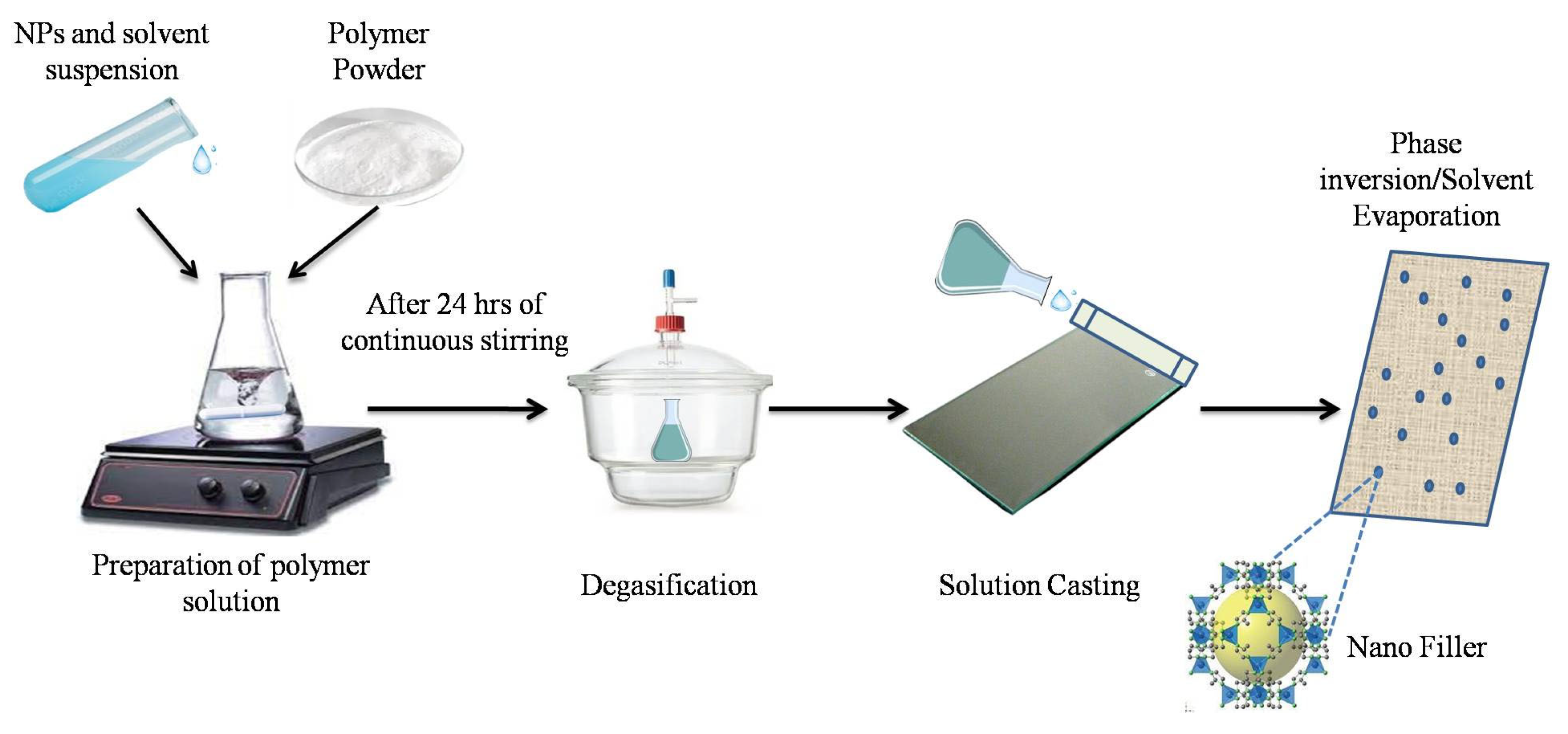
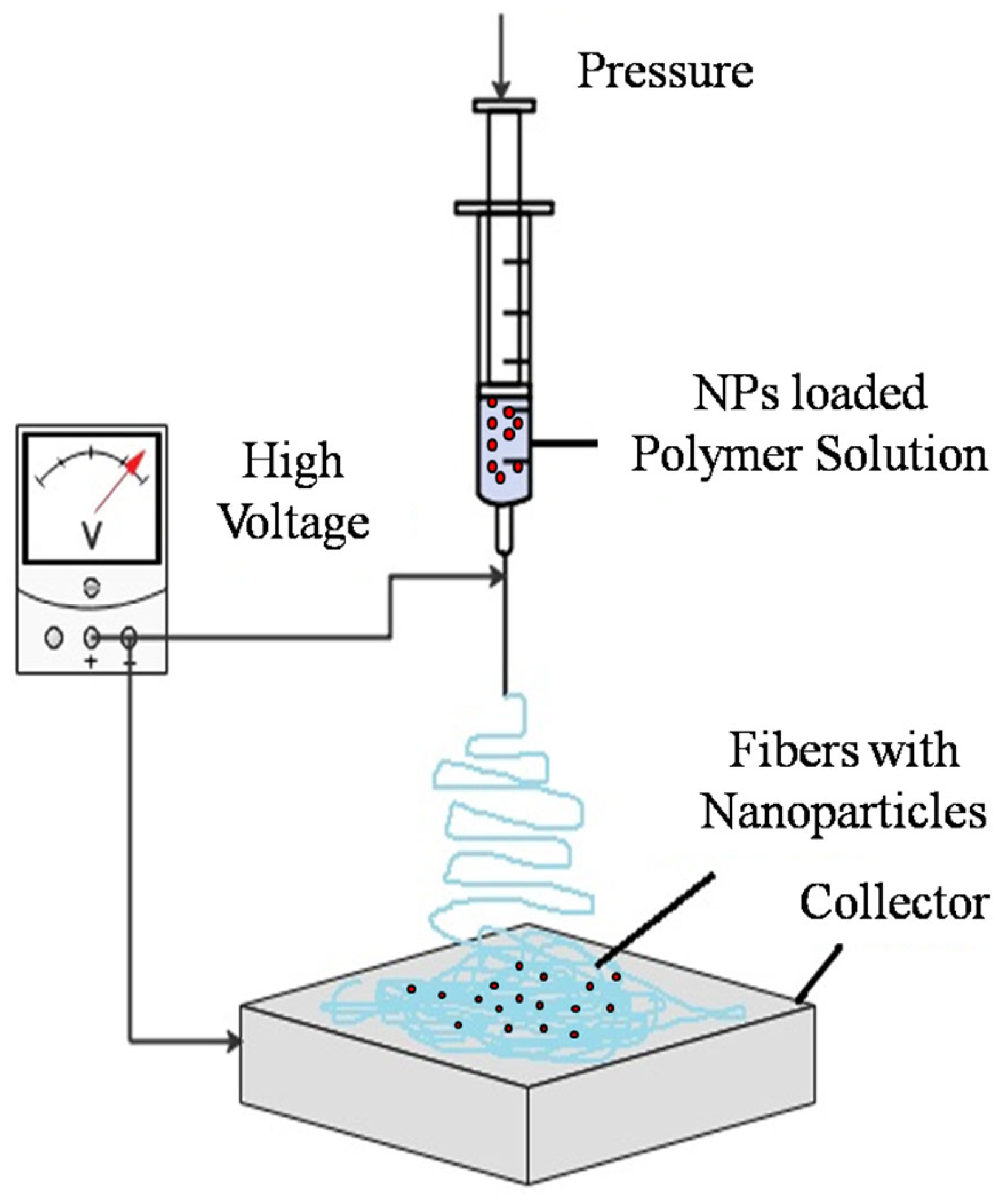
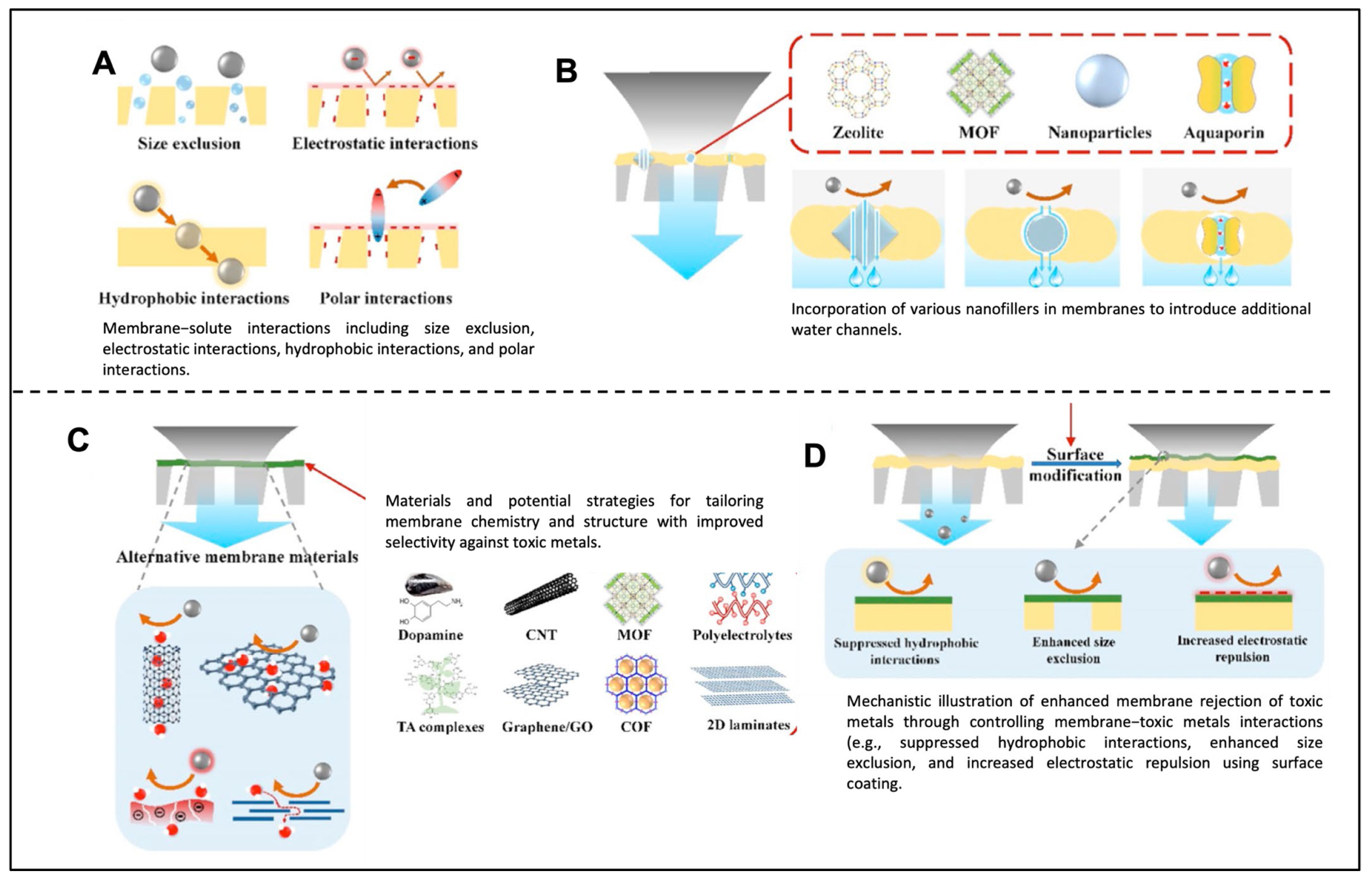
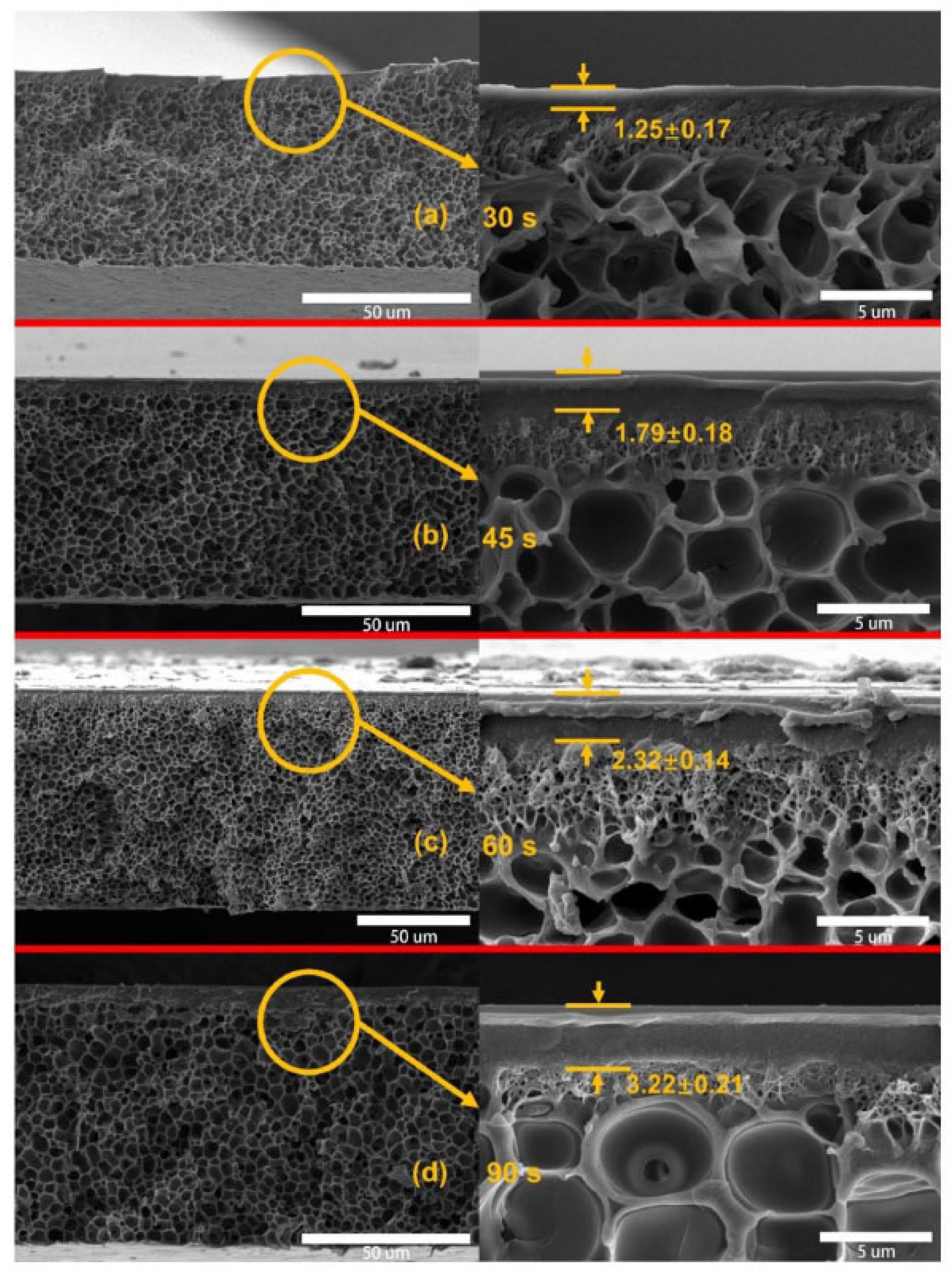
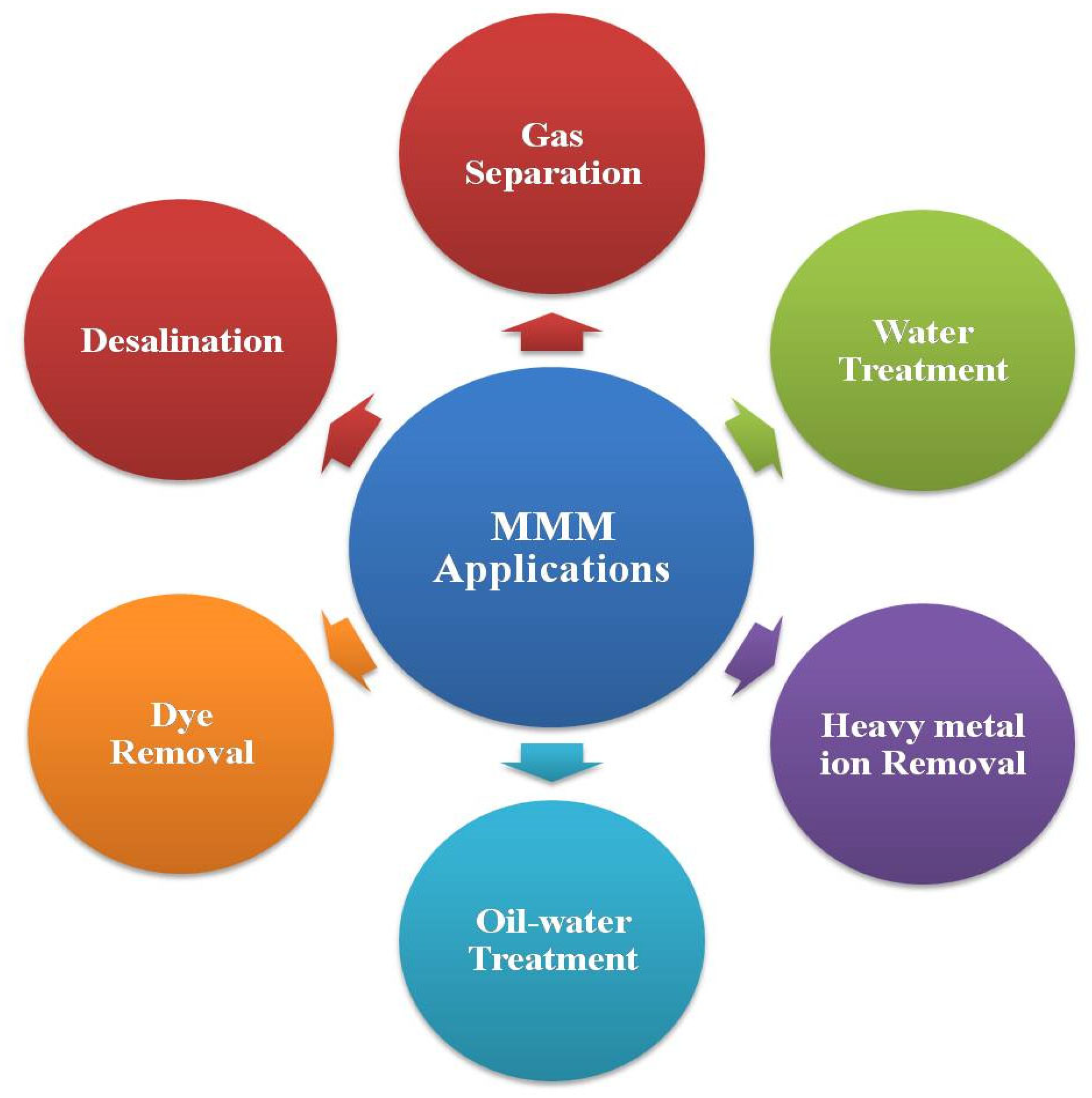
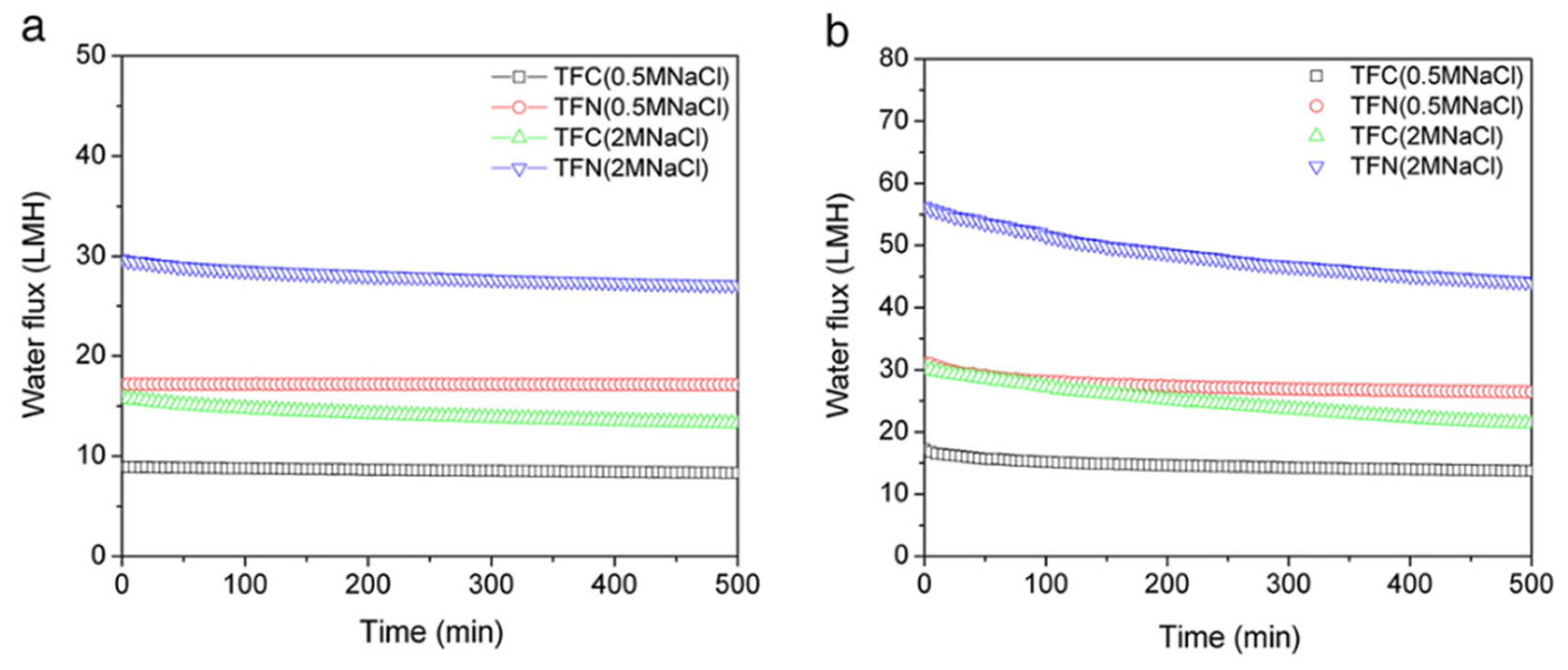

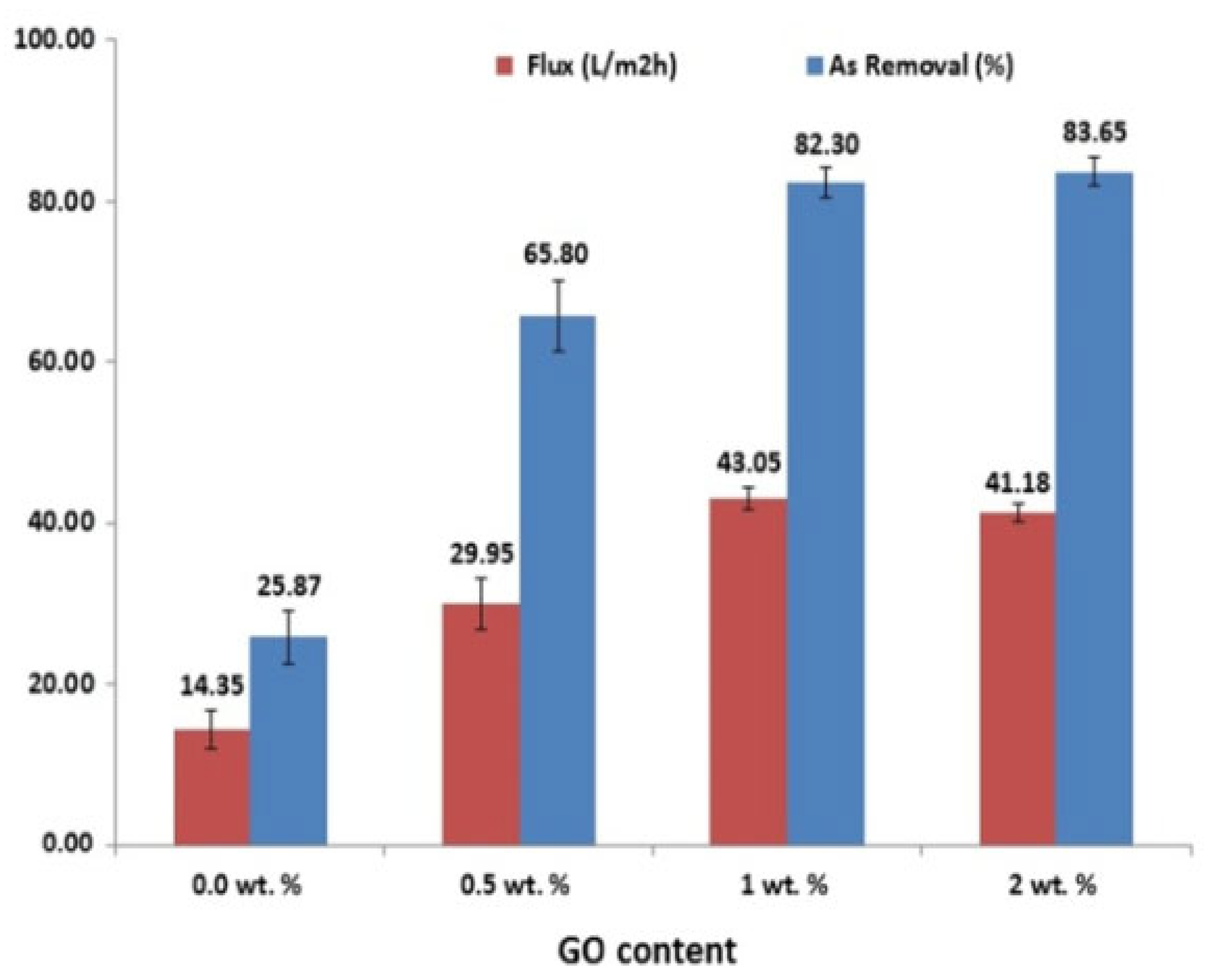
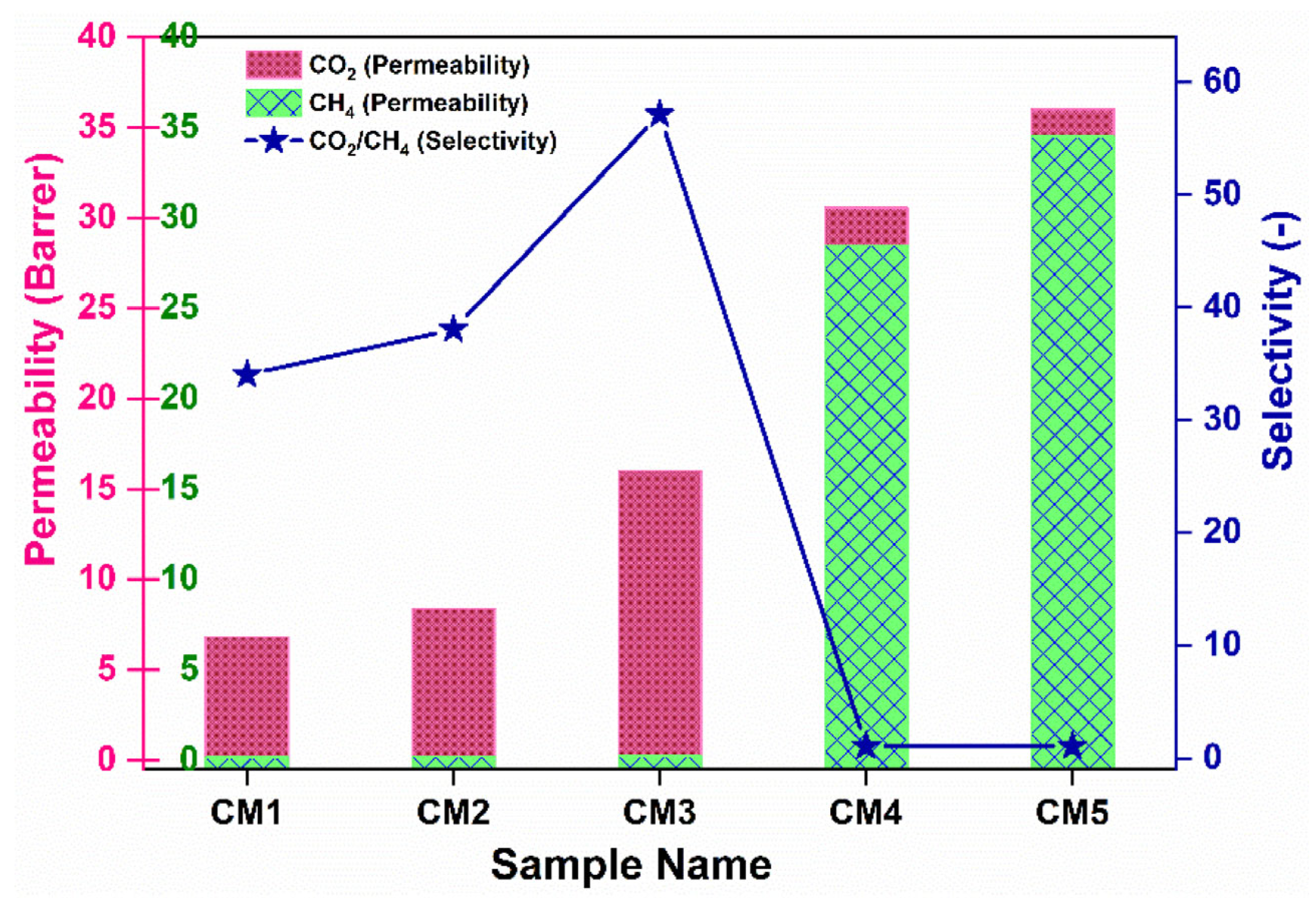
| S. No | Nanoparticles | Polymer | Key Findings | References |
|---|---|---|---|---|
| 1 | Ag-NPs | PES + PVP | Enhanced hydrophilicity, water permeability, protein flux, and BSA rejection | [85] |
| 2 | Cu-NPs | PES % | Superior antifouling and protein rejection compared to a pristine PES membrane | [86] |
| 3 | CuO-NPs | TFC-RO membrane on PSf substrate | Improved anti-biofouling but compromised desalination performance | [87] |
| 4 | Alumina (Al2O3) and Linda type L (LTL) zeolite NPs | PSF and PVP | Greater anti-adhesion efficiency to either P. aeruginosa or E. coli | [88] |
| 5 | Iron oxide (FeO) | PES | Enhanced hydrophilicity, flux, and salt rejection. | [89] |
| 6 | Zeoliticimidazolate framework-8 (ZIF-8) | PVDF | Increased water flux, high permeability, and FRR % | [90] |
| 7 | TiO2 | PES | Enhanced PWF, antifouling, and low flux decline. | [91] |
| S. No | Type of Dye | Nanoparticles | Polymeric | % Removal | Ref |
|---|---|---|---|---|---|
| 1. | Congo Red (CR) | Cobalt | PU | 60 | [108] |
| 2. | ZnO | PSf/PVA | 53.5 | [109] | |
| 3. | Mesoporous silica | PVDF/PTFE | 99% | [110] | |
| 4. | Hydrogen titanate | Chitosan | 98.7 | [111] | |
| 5. | TiO2 | PVDF-co-hexafluoropropylene (HFP) | >99.8 | [112] | |
| 6. | Indigo Dye | TiO2 | PVDF | 6.1 μmol L−1 min−1 | [113] |
| 7. | FeO-NPs | Sulfonated waste-expanded polystyrene | 99% | [114] | |
| 8. | Methyl Orange (MO) | Hyperbranched polyethyleneimine (HPEI)-templated TiO2 | PES | 70.3% | [115] |
| 9. | MO | ZnO | CA | 75% | [116] |
| 10. | MO, Methylene Blue (MB), and Rhodamine B (RhB) | Polydopamine (PDA)-immobilized TiO2 | Bacterial cellulose (BC) | MO-95.1% MB-99.5% RhB-100% | [117] |
| 11. | MO and Allura Red | Polyaniline-titanium nanotubes | PVDF | MO-90% AR-88% | [118] |
| 12. | RhB | Copper sulfide (Cus)/gelatin | PVA | 81% | [119] |
| S. No | Nanoparticles | Polymer | Selectivity | Reference |
|---|---|---|---|---|
| 1 | MWCNTs | PES + PEG + Pebax-1657 | The selectivity of the modified membrane for the CO2/N2 gas pair improved from 83.2 to 162 as the feed pressure increased from 1 to 3 MPa. For the H2/N2 and O2/N2 gas pairs, the selectivity values ranged from 82.5 to 90 and from 7.1 to 6.8, respectively. | [133] |
| 2 | Zeolite 4A | Pebax-1657 + PES | The permeability increased from 71.4 to 155.7 Barrers for CO2, 2.2 to 19.6 Barrers for CH4, 5.8 to 17.9 Barrers O2, and 1.4 to 12.0 Barrers for N2. The selectivity improved from 54.1 to 94.2 for the CO2/N2, 26.4 to 41.3 for CO2/CH4, and 4.3 to 4.9 for the O2/N2 gas pair with increasing feed pressure from 5 to 25 kg/cm2. | [134] |
| 3 | Nanosilica and H-Mordenite | PES + Pebax-1657 | The pressure increase from 10 to 30 kg/cm2 enhanced the permeance of the 0.3 wt% Si/Pebax membrane: CO2 (8.9 to 36.1 GPU), H2 (1.1 to 3.5 GPU), O2 (0.49 to 1.3 GPU), and N2 (0.12 to 0.43 GPU). The addition of H-Mordenite further increased permeance: CO2 (1.1 to 5.4 GPU), H2 (0.56 to 0.87 GPU), O2 (0.09 to 0.39 GPU), and N2 (0.03 to 0.205 GPU). | [135] |
| 4 | ZIF-8 | Matrimid 5218 | Enhanced gas permeability. | [136] |
| S. No | NP | Polymer | Recovery of | Pristine Membrane Flux | Modified Membrane Flux | Separation Factor Improvement | Reason for Enhancement | Reference |
|---|---|---|---|---|---|---|---|---|
| 1 | ZIF-7 | PDMS | Butanol from an aqueous solution | 1080 g/m2/h | 1689 g/m2/h | 51–66 | Enhanced the available space within the membrane matrix | [154] |
| 2 | TiO2 and TiO2 + Poly aniline (PANI) | PVA | Dehydration of IPA | PVA-TiO2 = 0.0221 kg/m2 h | PVA-TiO2-PANI = 0.0250 kg/m2 h | Selectivity is infinite for both membranes. | The presence of the emeraldine salt form of PANi increases hydrophilicity more than TiO2. | [155] |
| 3 | Dopamine-Ag (DAAg) | PDMS | Desulfurization | - | Three times the pristine PDMS membrane, i.e., 8.22 kg/m2/h | The enrichment factor is 5.03. It is 50% more than that of the PDMS membrane. | Facilitated transport of thiophene via reversible interaction with Ag(I) molecules increased separation performance by adjusting fractional free volume through DAAg NPs. | [156] |
| 4 | Nanosized silica particles with sulfonic acid groups (ST-GPE-S) | Chitosan | Dehydration of an ethanol–water solution | 420 g/(m2 h) | 410 g/(m2 h) | 919 | Silica nanoparticles increase water permeation in the chitosan polymer matrix by providing additional free volumes. | [157] |
| 5 | Ag-NPs | PVA | Dehydration of IPA | 3.18 × 10−2 kg/m2 h | 7.16 × 10−2 kg/m2 h | The separation factor improved from 244 to 634 | Incorporating Ag NPs into the membrane enhances interactions between the NPs and the membrane. | [158] |
| 6 | Alumina NPs (Al2O3) | Cellulose triacetate (CTA) | Desalination of hypersaline solutions | 2.2 kg/m2 h | 6.7 kg/m2 h | Salt rejection is 99.8% | The required activation energy for water molecules increased from 34.1 to 43.2 kJ/mol. | [159] |
| 7 | Cerium oxide (CeO2) | PVA | Dehydration of ethanol | 0.143 kg/m2 h | 0.567 kg/m2 h | Increased from 51.2 to 1821 | The presence of CeO2 NP in the PVA membrane increased the free water channels. | [160] |
Disclaimer/Publisher’s Note: The statements, opinions and data contained in all publications are solely those of the individual author(s) and contributor(s) and not of MDPI and/or the editor(s). MDPI and/or the editor(s) disclaim responsibility for any injury to people or property resulting from any ideas, methods, instructions or products referred to in the content. |
© 2024 by the authors. Licensee MDPI, Basel, Switzerland. This article is an open access article distributed under the terms and conditions of the Creative Commons Attribution (CC BY) license (https://creativecommons.org/licenses/by/4.0/).
Share and Cite
Arundhathi, B.; Pabba, M.; Raj, S.S.; Sahu, N.; Sridhar, S. Advancements in Mixed-Matrix Membranes for Various Separation Applications: State of the Art and Future Prospects. Membranes 2024, 14, 224. https://doi.org/10.3390/membranes14110224
Arundhathi B, Pabba M, Raj SS, Sahu N, Sridhar S. Advancements in Mixed-Matrix Membranes for Various Separation Applications: State of the Art and Future Prospects. Membranes. 2024; 14(11):224. https://doi.org/10.3390/membranes14110224
Chicago/Turabian StyleArundhathi, Bhoga, Manideep Pabba, Shrisha S. Raj, Nivedita Sahu, and Sundergopal Sridhar. 2024. "Advancements in Mixed-Matrix Membranes for Various Separation Applications: State of the Art and Future Prospects" Membranes 14, no. 11: 224. https://doi.org/10.3390/membranes14110224
APA StyleArundhathi, B., Pabba, M., Raj, S. S., Sahu, N., & Sridhar, S. (2024). Advancements in Mixed-Matrix Membranes for Various Separation Applications: State of the Art and Future Prospects. Membranes, 14(11), 224. https://doi.org/10.3390/membranes14110224









